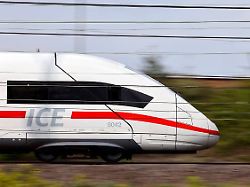charges for passengers
Bahn wants to rehabilitate more than 40 sections of track
02/09/2023, 6:00 p.m
Deutsche Bahn was less punctual than ever last year. In order to change this, the group wants to renovate around 40 sections of track nationwide in one go. For passengers, this initially means additional stress.
Complete closures, replacement traffic, diversions: Before the train can be more reliable and punctual, passengers will face further burdens in the coming years. By 2030, the group wants to completely renovate dozens of busy sections of road. For this purpose, the corridors will be completely closed for around five months and completely renovated and modernized. The idea: Instead of just repairing the bare essentials with small construction sites during ongoing operations, everything is done in one go. But then there should be peace for years and the train traffic should flow more reliably.
The group has now presented a concept as to when which route sections should be added in the coming years. The railway lists more than 40 such corridors in the paper available to the German Press Agency. The “Tagesspiegel” had previously reported. Deutsche Bahn representatives discussed the document together with companies and industry associations. After all, competitors in freight and passenger transport are also affected by the construction sites and have to create alternatives for their passengers and customers.
Doubts about feasibility
According to the concept, there are more than 40 sections with a total length of around 4200 kilometers. Deutsche Bahn had already announced the first three: the Riedbahn between Frankfurt and Mannheim will be completely renovated from mid-2024. The Emmerich-Oberhausen route, which is particularly important for freight traffic, follows the following year. The Hamburg-Berlin route is also on the program. The paper uses a scenario to describe how things could continue: According to this, the industry has spoken out in favor of orienting the periods to construction work that is planned anyway and ongoing projects. The Cologne-Hagen, Hamburg-Hanover and Nuremberg-Regensburg sections could follow in 2026. Other plans include: Cologne-Dortmund-Hamm (2027), Würzburg-Nuremberg (2028), Stuttgart-Ulm (2029) and Osnabrück-Münster (2030).
The railway emphasized that a final decision on the schedule and corridors had to be made with the federal government. “I’m glad that we can now go into further talks with a specific proposal,” said Infrastructure Board Member Berthold Huber. “For this, the exchange with the industry is an important basis.” The construction work poses a number of challenges. Not only does the train have to whip detour routes into shape in good time. Substitute transport, especially with buses, must also be advertised. Some in the industry are skeptical that enough vehicles and drivers can be found at all.
“Our fundamental support for the planned new approach to the rehabilitation of the existing rail network is being put to the test,” said Peter Westenberger, Managing Director of the European Railway Network. In the association, above all, the rail competitors in freight transport are organized. “We are concerned that in many of the rehabilitation sections, a complete rerouting of freight traffic in the existing network is not possible due to a lack of suitable routes.” A glimmer of hope for customers: Deutsche Bahn is convinced that punctuality and reliability will improve significantly with the first renovated corridors. The Riedbahn, for example, is one of the busiest routes in Germany. Smooth train traffic there has a positive effect on the entire network.
